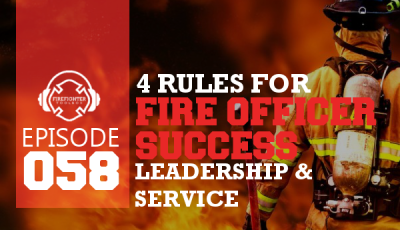I’m Not a Bad Fire Service Leader…Am I?
I’m not a bad fire service leader…am I?
Unfortunately, much of what’s written about leadership paints it as a neat and tidy skill set. That if you follow a simple algorithm or read a leadership blog, you’ll reach your objective 100% of the time.
In reality, leadership is full of uncertainty, self-doubt, criticism, and wondering at times ”what’s the point?” It’s having team members tell you they don’t care what you think, could care less about training, have no desire to support each other, and the job is nothing more than just a paycheck to them.
It’s watching people you grow to care about tear down everything in their lives as they struggle with divorce, substance abuse, or mental illness. It’s hearing rumors about you that don’t contain an ounce of truth, and stories that paint you as a bad guy; one not to be trusted. It can be a lonely place where the thought can set in…I’m not a bad leader am I?
When doubts like this creep into the picture, we need to shift our focus to how are we responding to what’s happening around us. Resiliency, at its core, is simply how well are we able to reply to life and its curveballs.
Leadership isn’t just an opportunity, where we get to do the things we love all the time. It’s messy, complicated, and involves peoples’ personal and professional problems.
It is also often more about change than it is maintaining status quo – and that’s scary and threatening to people at times. People, especially leaders, are constantly flooded with professional and personal events that cause stress to their lives (and families). The concept of resiliency is one where our minds and hearts are prepared to face these challenges.
Does making mistakes hurt our credibility as leaders?…Absolutely not!
As a leader, you might have experienced a lot of days where things couldn’t possibly have gone any better. Perhaps it was the way your team operated on the fire ground, a quick in-service around a tool or the pump panel, or maybe it was the great way a difficult conversation was handled with a co-worker, maybe who is even a personal friend. Success recharges our leadership batteries and has us eager for the next challenge.
But you should remember moments like these for when the opposite happens, and things don’t go so well. And believe me, those days do happen. Most leaders don’t like to talk about days like these, because, well let’s face it: those days force us to admit to others that we don’t have all the answers, and we make mistakes. If we let on that leadership is hard, sometimes really hard, then who would want to do it?
More so, if we let on as leaders that we make mistakes, doesn’t that hurt our credibility? Absolutely not!
The fire service has a proud culture which predisposes us at times to “Monday-morning-quarterback” others – be it on the fire ground or around the station. We won’t even let distance stop us, using the internet and firefighter rumor mills to tear down other department’s tactics or leadership.
Some anonymous fire department junkie with no credibility is more than happy to blow up your department on YouTube or social media. Sometimes it’s good-natured, and sometimes it’s akin to character assassination. But if you can listen and pay attention, your body is trying to teach you something that might just recover your flame for helping and leading others burning bright.
Perfect isn’t possible: Take a hint from your body
We all learned that the body has an ideal set of conditions it likes to maintain to be healthy (homeostasis). EMT-Basic taught us that 7.35-7.45 is the range of the body’s PH it can tolerate quite well, while it is simultaneously working to compensate for life’s events.
The body has a primary way it likes to work when things are running smooth (aerobic respiration), but it also has a backup way in case an increased demand arises (anaerobic respiration). There is a consequence when the body has to use this backup way, especially if it’s for a prolonged period of time. Things start to become acidic (negative), and the body can become toxic quickly if not fixed. Are you starting to see the parallels yet to how we respond as leaders?
When we lead with a positive leadership pH (or aerobically), it feels natural and we do so by sharing our values and vision with our team. But at times, employees or even our personal lives throw us curves, and the temptation is to lead with authority, which is akin to our body’s backup way of facing demands. We can easily slip into leading with “because I said so”, or by quoting policy like it is scripture. But that too, has a consequence, and it alters our Leadership pH (anaerobically), which isn’t healthy for the team over the long-term, and quite frankly the toxic result can be the death of good leadership.
We have all experienced the scenario where the arrival or the mere mention of a single person turns the thinking and actions of an entire group toxic. If this person happens to be the leader, then the effect is magnified exponentially.
The most important thing to understand is, the body has acknowledged that it will never, ever be at a single fixed and set point. It will constantly and forever be chasing an ideal range, responding to stresses, and this give and take is what allows you to be healthy.
Leadership must do the same. Understand you can never reach the perfect version of you, that frequently we are told could exist if we just did one thing differently, or a little better. Rather, acknowledge when things go well, and forgive yourself when they don’t. Acknowledging this is your first lesson to improving your resiliency.
Action Plan:
1. Support other leaders in your organization, especially when you realize they have a negative Leadership pH. Help them compensate for whatever life or professional challenge they are facing.
2. Engage employees who maintain negative pH, so they don’t have the opportunity to ruin teams and leaders. Be aware of what that looks like, and have people in your life that will provide you honest feedback if you are becoming negative or toxic.
2. Above all, remember it’s a powerful thing when you feel the support of others. I like to think it’s similar to how respect is earned: you have to give it, to receive it.
Resiliency is a large topic and we have much to discuss. But if you’ve experienced or seen leadership fatigue and burnout, then you understand the importance of leaders supporting each other.
In part two, we will discuss resiliency from critics. See you in the comments section.
Photo Courtesy of the Author
Leadership Resiliency and Recovery in the Fire Service: An Introduction– Part 1 of 7










Lt Martin – great jib! Looking forward to the other installments.
Dave,
Thanks so much for the feedback!